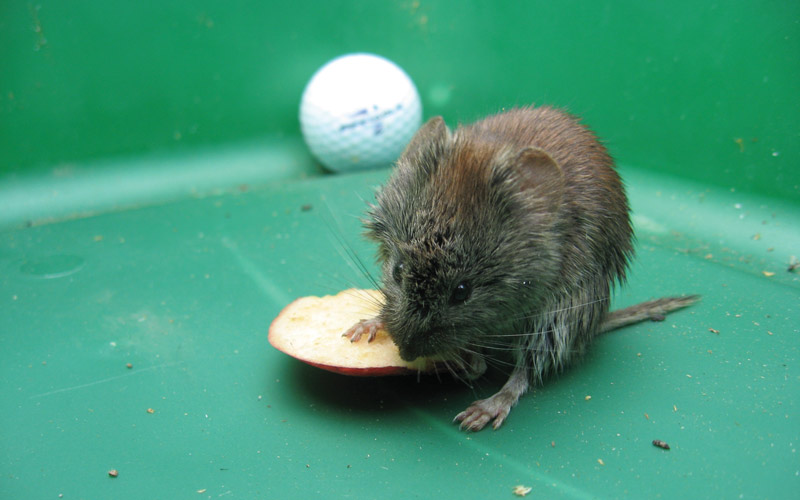
Voles may be cute and furry, but the damage they inflict on turf is troublesome for golf course superintendents. Photos by Jim Knight
More than 20 vole species (Microtus species) are found throughout the United States, and all of them cause widespread and significant economic damage to golf courses. Every spring, superintendents receive a surprise when snowmelt reveals little trails scattered along fairways and other turfgrass areas. The voles have been at work all winter under the snow, removing green vegetation down to the soil and creating a maze of runways and bare patches. On most golf courses, vole control is a never-ending task and a never-ending frustration for superintendents.
Through persistence and creativity, it is possible to offset vole damage. Even the frustrating failures will be interspersed with satisfaction resulting from the large natural population fluctuations that are characteristic every two to five years.
Vole habitat and biology
Voles occupy a wide variety of habitat, but they are normally found near areas with heavy ground cover of grass or other dense vegetation. Generally, the damage that occurs on golf courses is adjacent to natural areas of long-term vole habitat. Voles do not hibernate and are active day and night throughout the year. Their home range is usually a quarter acre (0.1 hectare) or less, but it varies with the season, population density, habitat and food supplies. Voles construct many tunnels and surface runways with several burrow entrances. One burrow system may contain several adults and their young.
Population levels
In just six months, a female vole has the biological potential to have more than 40,000 grandchildren. Luckily, the average vole lives less than a month, and natural mortality factors keep them from reaching their full reproductive potential.
Voles breed throughout the year but most commonly in the spring and summer. They generally have one to five litters per year, and the litter size ranges from one to 11 but is usually three to six. The gestation period is 21 days, and females mature in 35 to 40 days, but under ideal conditions, females may breed as early as two weeks of age. Their life span is short, ranging from two to 16 months once adulthood is reached.
Population densities of voles are variable. Research has shown that populations range from about two to more than 50 per acre (20/hectare) in normal grasslands, but populations in alfalfa are often more than 100 voles per acre (40/hectare). The highest reported density was during a 1957 population irruption in Oregon where voles numbered 4,000 per acre (1,619/hectare).
Diet
Voles eat a wide variety of plants, but most frequently they feed on grasses and forbs. In the summer and fall they store seeds, tubers, bulbs and rhizomes. Occasional foods include insects, animal remains and small animals such as snails.
Identifying vole damage
On golf courses, most damage results from the vole’s extensive runway and tunnel system. Turfgrass is damaged when the well-traveled runways and adjacent areas are clipped close to the ground by feeding voles. Feces and small pieces of vegetation are readily evident in the runways. Excessive urine and feces can sometimes make re-establishment of grasses a challenge.
Voles may cause damage as they girdle trees and seedlings and damage roots. Tiny marks from vole incisors can be seen, which helps differentiate vole damage from other causes of bark removal or root damage.
Controlling vole damage on the golf course
Voles are classified as nongame mammals that can be controlled when they cause damage. Always follow label instructions when using toxicants, and contact your state wildlife agency for details regarding local codes and regulations for wildlife control.
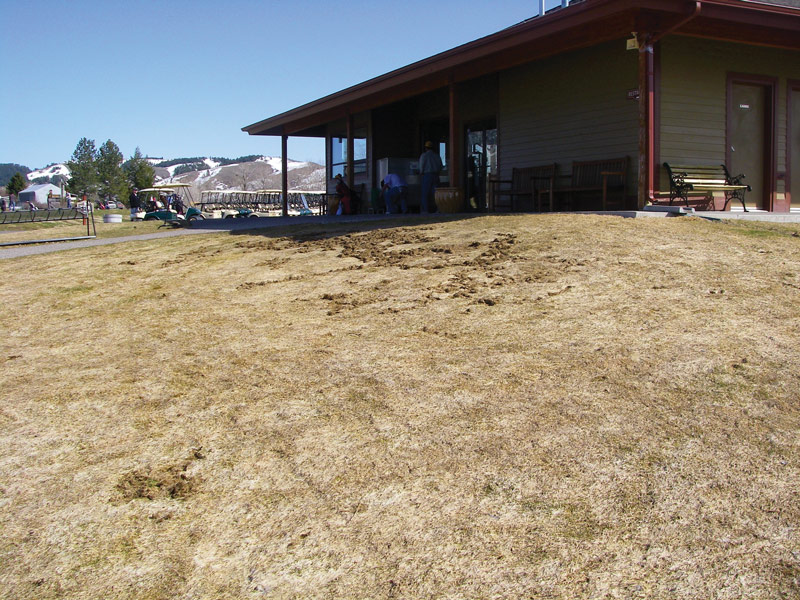
Voles’ winter activities can make for surprise turf injury come spring. After snow is gone, the damage becomes evident.
Preventing damage to trees, fairways and other turf areas has resulted in development of an impressive array of methods and techniques. Success in controlling vole damage will be higher if a variety of methods are used to address the problems. As with any wildlife damage control, consider exclusion methods, cultural methods, habitat modification, frightening devices, repellents, toxicants, fumigants, trapping and other methods that may be appropriate for a particular species.
Exclusion
Exclusion is often the best method to protect seedlings and young trees. Hardware cloth (galvanized wire screen) cylinders and some commercially made plastic cylinders are very effective when used properly. The mesh should be 0.25 inch (0.64 centimeter) or smaller and must be buried 6 inches (15.2 centimeters) to keep the voles from burrowing under the cylinders. Be sure the cylinders are above the expected snow level.
Cultural methods
Cultural methods revolve around strategies to interrupt cover or travel for voles. Voles travel very well under snow if they can move freely through vegetation or loose material between the soil and the snow. Eliminating this layer is the key to preventing vole movement during winter.
Packed snow can obstruct vole movements between native grass areas and fairways. It has been found that voles are reluctant to go over the top of packed snow areas they cannot burrow through. To maintain these packed areas, some golf courses have used snowmobiles or developed cross-country ski trails along fairways.
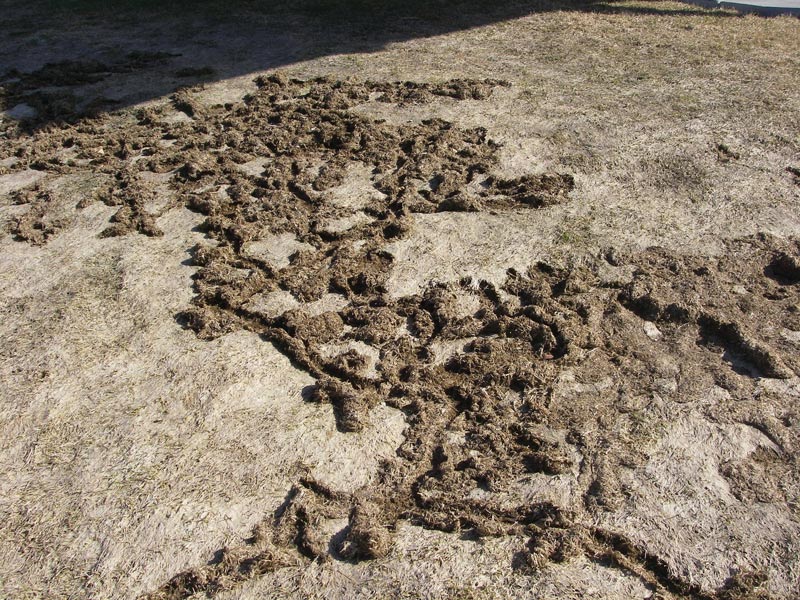
Runways made by voles during winter will cause unsightly turf damage, the result of short clipping and concentrated deposits of feces and urine.
Cultural methods that reduce the likelihood of vole damage to trees include the elimination of weeds, grass, litter and loose mulch around seedlings. Mowing grass short around trees will reduce the ease of vole travel.
Soil tillage is effective in reducing vole damage because it removes cover and destroys vole tunnels. Some golf courses have reduced damage to fairways by fall-tilling an 8-foot (2.4-meter) strip between tall native grass areas and frequently damaged fairways. This tilled area can be replanted each spring to improve aesthetics.
The shorter the grass, the more difficult it will be for voles to move from one area to another during winter. Although superintendents have strong opinions about optimal grass length going into winter, cutting grass as short as possible in a 10-foot (3-meter) swath next to native grass areas will make it difficult for voles to move into other areas under the snow.
Completely burning tall grass areas or burning at least a 10- to 20-foot (3- to 6-meter) corridor between tall grass areas and fairways will also inhibit vole movement into turfgrass.
Frightening devices
Devices intended to frighten voles are not effective in reducing vole damage. A large variety of frightening devices that claim to keep rodents away — lights, sounds and numerous ultrasonic devices — have been tested, and none has proven effective in controlled experiments.
Repellents
Repellents with the active ingredients thiram or capsaicin are registered for meadow voles and may provide some short-term protection. Because repellents must be reapplied often, using them to prevent vole damage on golf courses is usually not practical.
Zinc phosphide baits
The most common toxicant for voles is zinc phosphide, a single-dose toxicant available in pellet and grain-bait formulations. Where legal, zinc phosphide can be broadcast at 6 to 10 pounds/acre (6.7 to 11.2 kilograms/hectare) or placed by hand in runways and burrow openings. However, zinc phosphide baits are potentially hazardous to ground-feeding birds, especially waterfowl. This hazard can be reduced by placing bait in burrows. Because of concerns related to broadcasting zinc phosphide and because of the difficulty and time required to locate burrow openings, zinc phosphide is not practical in many golf course situations.
Anticoagulant baits
Anticoagulant toxicant baits can be very effective in controlling voles. Because voles must feed on anticoagulant baits for several days for most of these baits to be effective, bait stations are often used. In addition to providing a ready and ample supply of the anticoagulant, bait stations protect the bait from moisture and make it unavailable to most nontarget species. Be sure to follow label instructions.
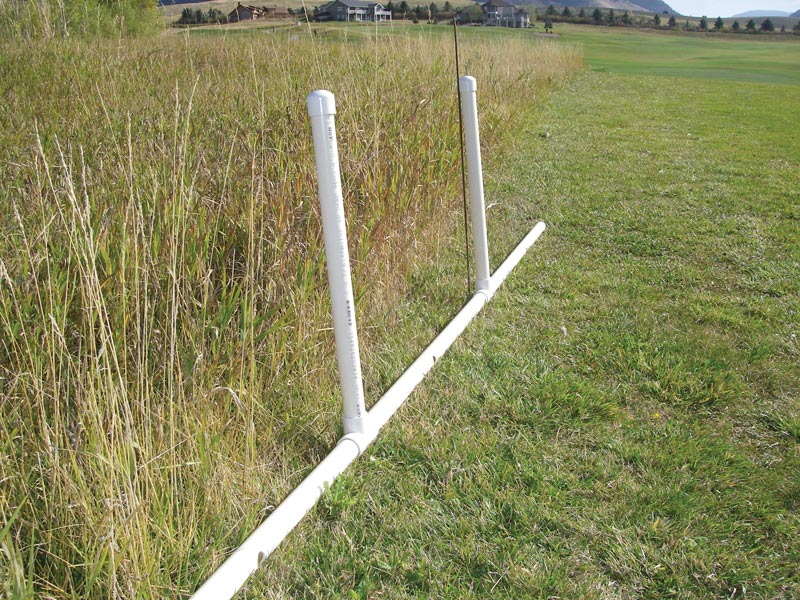
Anticoagulant bait stations should be placed before snowfall in areas adjacent to historically damaged turfgrass.
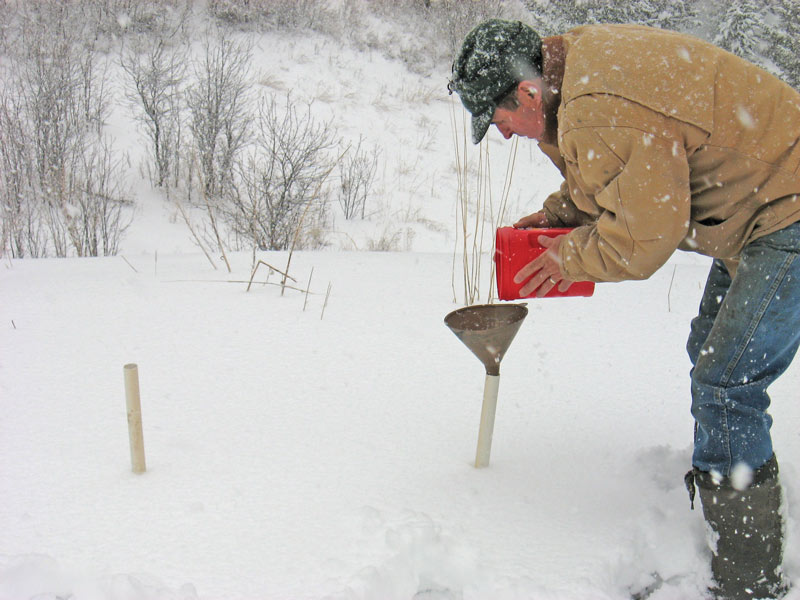
Successful vole control requires a continuous supply of anticoagulant bait.
Bait stations are available commercially in box, tube or container form, or they can also be constructed from 1.25-inch (3.2-millimeter) PVC pipe. Their design allows the bait stations to be refilled easily even when they are covered by snow. To build a bait station, drill 1-inch (2.5-centimeter) entry holes on alternating sides every 12 inches along a 10-foot (3-meter) length of horizontal PVC pipe. Use standard PVC “T’s” to attach 2-foot (0.6-meter) upright pipe sections every 3 to 4 feet (0.9 to 1.2 meters). The upright pipes act as storage containers for the anticoagulant bait. Put caps on top of the upright sections to make them weatherproof. Tie the upright pipes to stakes to keep them in place.
As voles enter the horizontal pipe and feed on the bait, bait from the upright storage falls down to provide a continual supply. The stations must be checked continually to ensure bait is always available. Stations need to be put in place before early snow and should be distributed along native or meadow areas adjacent to fairways or other grassy areas meant to be protected.
Fumigants
Some fumigants are registered for vole control, but they usually are not effective because of the complexity of the burrow system. The fumigant is hard to contain, and it is unlikely that a significant percentage of voles in the burrow system will be killed.
Trapping
Trapping is usually not effective in controlling large vole populations because the time, labor and number of traps used can be excessive. For small populations, snap traps (mouse traps) baited with peanut butter will work. Place the traps in small boxes with 1-inch (2.5-centimeter) holes cut out on each side.
Predators
Voles are prey for many predators —including coyotes, snakes, hawks, owls and weasels — because voles are relatively easy to catch, they are active day and night, and they are abundant. However, because of the voles’ high reproductive rate, predators are unlikely to control vole populations.
Propane exploders
Propane exploders are injecting devices used to fill the vole burrow system with propane, which is then ignited. The resulting explosion is certainly satisfying, and some operators have reported a certain degree of control. However, the devices are expensive, and the limitations related to the use of fumigants also apply to the propane injections. The complexity of the burrow system makes the propane hard to contain, and it is unlikely that a significant percentage of voles in the burrow system will be killed. Some voles may be killed, but, overall, propane exploders are not an effective method of control.
Conclusions
Controlling voles on golf courses is a never-ending task, and there is no sure-fire method or technique. The creativity of many superintendents has resulted in a variety of methods that sometimes work and sometimes are just a way to feel we are not totally at the mercy of the pests. Voles are one wildlife species that must be controlled on a continual basis. Planning is very important for vole control because much of the work to control populations and winter damage must be put in place in the fall.
References
- Byers, R.E. 1985. Management and control. p. 621-646. In: R.A. Tamarin, editor, Biology of new world Microtus. American Society of Mammalogists, Shippensburg, Pa.
- Clark, J.P. 1986. Vertebrate pest control handbook. California Department of Food and Agriculture, Sacramento, Calif.
- Johnson, M.L., and S. Johnson. 1982. Voles. p. 326-354. In: J.A. Chapman and G.A. Feldhamer, editors. Wild mammals of North America: Biology, management, and economics. Johns Hopkins University Press, Baltimore.
- O’Brian, J.M. Voles. Internet Center for Wildlife Damage Management (https://icwdm.org).
Jim Knight is a professor and Extension wildlife specialist at Montana State University. He specializes in practical wildlife management and conducts seminars and workshops on wildlife damage control. He is particularly interested in hearing from superintendents about their best techniques for wildlife management.